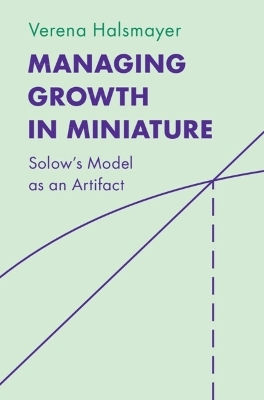
Managing Growth in Miniature
Solow's Model as an Artifact
Seiten
2024
Cambridge University Press (Verlag)
978-1-316-51518-1 (ISBN)
Cambridge University Press (Verlag)
978-1-316-51518-1 (ISBN)
This book offers the first richly layered and contextualized history of the famed 'Solow model' between the 1930s and the 1960s. Attending to the concrete sides of economic abstractions, it provides an accessible account of the forms of knowledge that shaped the predominant notion of 'economic growth' and its discontents.
Managing Growth in Miniature explores the history of the way economists think about growth. It focuses on the period between the 1930s and 1960s, tracing the development of the famed 'Solow growth model,' one of the central mathematical models in postwar economics. It argues that models are not simply 'efficient tools' providing answers to the problems of economic theory and governance. The Solow model's various uses and interpretations related not only to the ways it made things (in)visible, excluded questions, and suggested actions. Its 'success' and effects ultimately also pertained to its fundamental ambiguities. Attending to the concrete sides of economic abstractions, this book provides a richly layered and accessible account of the forms of knowledge that shaped the predominant notion of 'economic growth' and ideas of how to govern it.
Managing Growth in Miniature explores the history of the way economists think about growth. It focuses on the period between the 1930s and 1960s, tracing the development of the famed 'Solow growth model,' one of the central mathematical models in postwar economics. It argues that models are not simply 'efficient tools' providing answers to the problems of economic theory and governance. The Solow model's various uses and interpretations related not only to the ways it made things (in)visible, excluded questions, and suggested actions. Its 'success' and effects ultimately also pertained to its fundamental ambiguities. Attending to the concrete sides of economic abstractions, this book provides a richly layered and accessible account of the forms of knowledge that shaped the predominant notion of 'economic growth' and ideas of how to govern it.
Verena Halsmayer is a senior research and teaching fellow (Oberassistentin) at the University of Lucerne's Chair for Science Studies. Her dissertation, on which this book is loosely based, received the Best Dissertation Award of the Faculty of Historical Cultural Studies at the University of Vienna.
Introduction; 1. The artifact and the experimental report; 2. The problematic of growth and productivity; 3. Modeling the economic system; 4. Growth en miniature; 5. Model talk; Epilogue.
| Erscheinungsdatum | 29.10.2024 |
|---|---|
| Reihe/Serie | Historical Perspectives on Modern Economics |
| Zusatzinfo | Worked examples or Exercises |
| Verlagsort | Cambridge |
| Sprache | englisch |
| Gewicht | 586 g |
| Themenwelt | Geschichte ► Teilgebiete der Geschichte ► Wirtschaftsgeschichte |
| Naturwissenschaften | |
| Wirtschaft ► Allgemeines / Lexika | |
| Wirtschaft ► Volkswirtschaftslehre ► Makroökonomie | |
| ISBN-10 | 1-316-51518-4 / 1316515184 |
| ISBN-13 | 978-1-316-51518-1 / 9781316515181 |
| Zustand | Neuware |
| Informationen gemäß Produktsicherheitsverordnung (GPSR) | |
| Haben Sie eine Frage zum Produkt? |
Mehr entdecken
aus dem Bereich
aus dem Bereich
Macht und Herrschaft im Zarenreich
Buch | Hardcover (2024)
C.H.Beck (Verlag)
49,90 €


